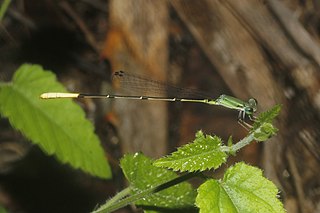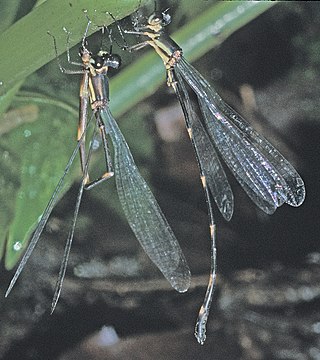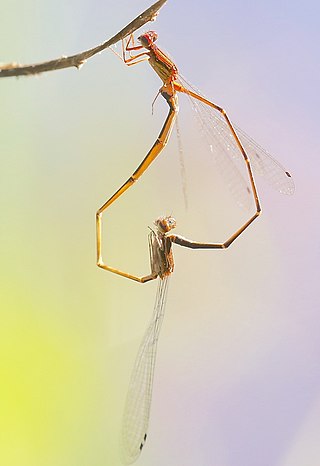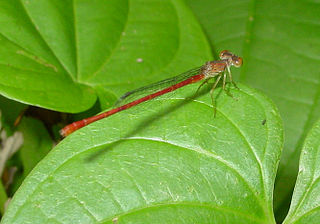
The Pseudostigmatidae are a family of tropical damselflies, known as helicopter damselflies, giant damselflies, or forest giants. The family includes the largest of all damselfly species. They specialize in preying on web-building spiders, and breed in phytotelmata, the small bodies of water held by plants such as bromeliads.
Diceratobasis is a genus of damselfly in the family Coenagrionidae. The larva of species in this genus live in water that is trapped in bromeliads.
Epigomphus is a genus of dragonflies in the family Gomphidae. They are commonly known as knobtails.

Gynacantha is a genus of dragonflies in the family Aeshnidae. The females have two prominent spines under the last abdominal segment. This gives the genus name and the common name two-spined darners; they are also known as duskhawkers.
Hypopetalia pestilens, the white-dotted redspot, is a monotypic species of dragonfly in the family Austropetaliidae. It is endemic to central Chile. Its natural habitat is rivers. It is threatened by habitat loss.

Leptobasis is a small genus of damselflies in the family Coenagrionidae. They are commonly known as swampdamsels. The genus is neotropical and one species, L. melinogaster, has been recorded in Texas. They are slender and the females have very long ovipositors.

Mecistogaster amalia is a species of damselfly in the family Coenagrionidae known commonly as the Amalia helicopter. It is endemic to Brazil, where it lives in Atlantic rainforest.
Mecistogaster pronoti is a species of damselfly in the family Coenagrionidae. It is endemic to Brazil. Its natural habitat is subtropical or tropical moist lowland forests. It is considered as critically endangered and is threatened by habitat loss.

Neoneura is a genus of damselfly in the threadtail family Coenagrionidae. They are found in the Neotropics, from Cuba and Texas to Argentina.

Palaemnema is a genus of dragonflies in the family Platystictidae. They are commonly known as shadowdamsels and are found in the New World, from Arizona to Peru and French Guiana.

Phyllopetalia is a genus of dragonflies in the family Austropetaliidae. They are commonly known as redspots.
Phylolestes is a monotypic genus of damselflies in the family Synlestidae. It contains the single species Phylolestes ethelae, the Hispaniolan malachite. It is endemic to the island of Hispaniola, where it occurs in both the Dominican Republic and Haiti.

Progomphus is a genus of medium-sized dragonflies in the family Gomphidae. They are found in the Americas and are largely tropical. They are one of the few Gomphids with coloured wings.

Protoneura is a genus of damselfly in the family Coenagrionidae. It contains the following species:

Perithemis is a genus of dragonflies commonly known as Amberwings. They are characterized by their small size and the amber wings of the male.

Telebasis is a genus of damselflies in the family Coenagrionidae. The genus occurs in the Neotropics. Most of the species are red with a few blue species in South America.

Orthemis is a genus of large Neotropical dragonflies, commonly called Tropical King Skimmers. The males are generally red and the females brown.

Micrathyria is a Neotropical genus of dragonflies. They have bright green eyes and white faces. Most species have a markedly striped thorax. They are commonly known as Tropical Dashers.
Mecistogaster buckleyi is a species of damselfly in the family Coenagrionidae. It is found in South America.

Mecistogaster ornata, the lemon-tipped helicopter, or ornate helicopter, is a species of narrow-winged damselfly in the family Coenagrionidae. It is found in Central America and South America.














